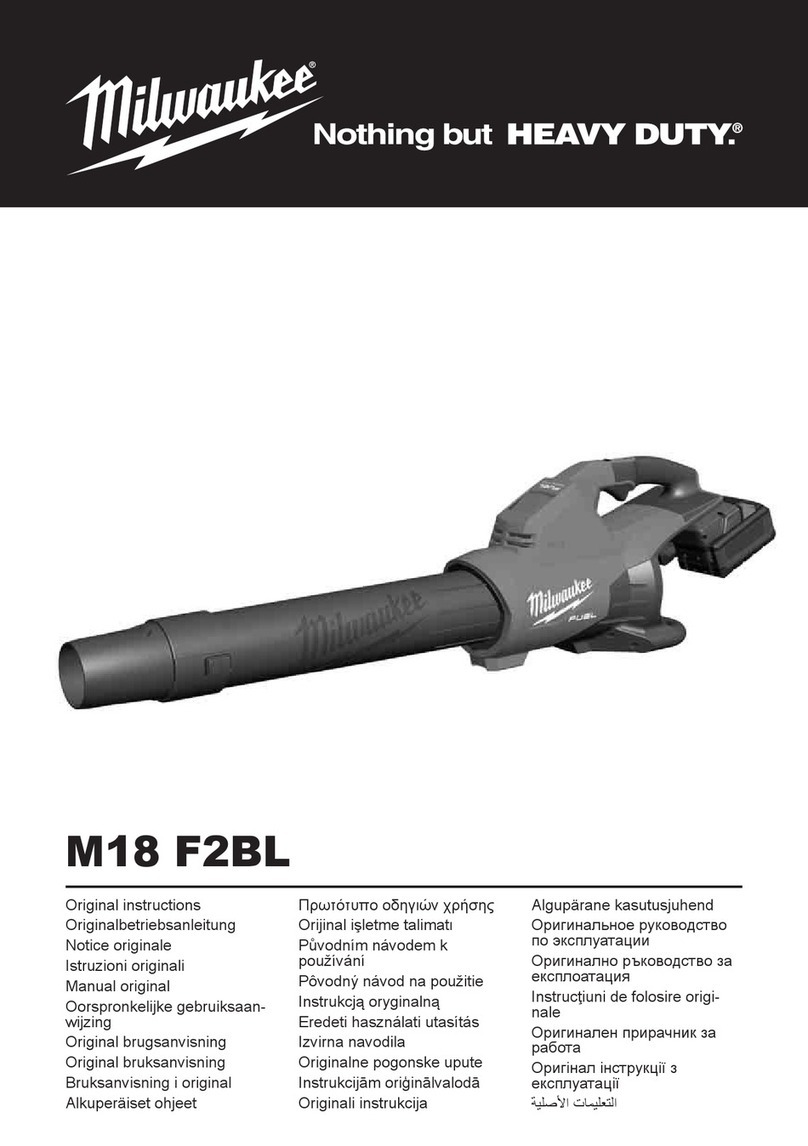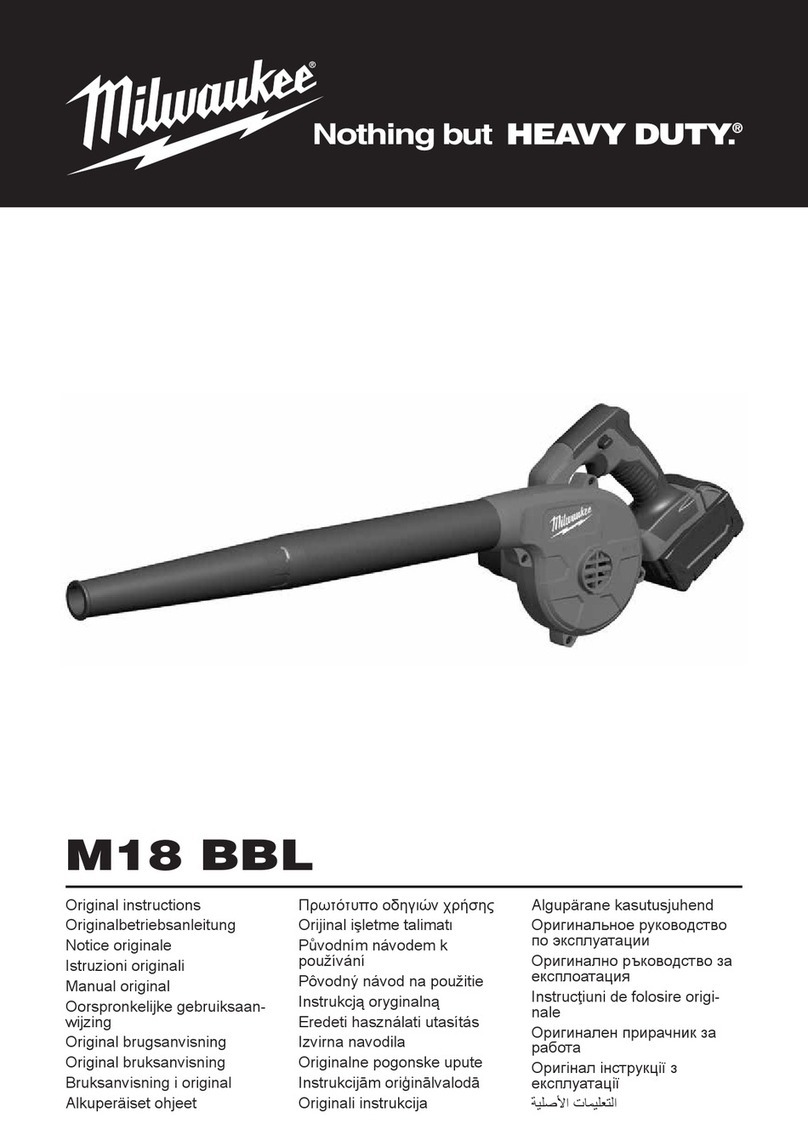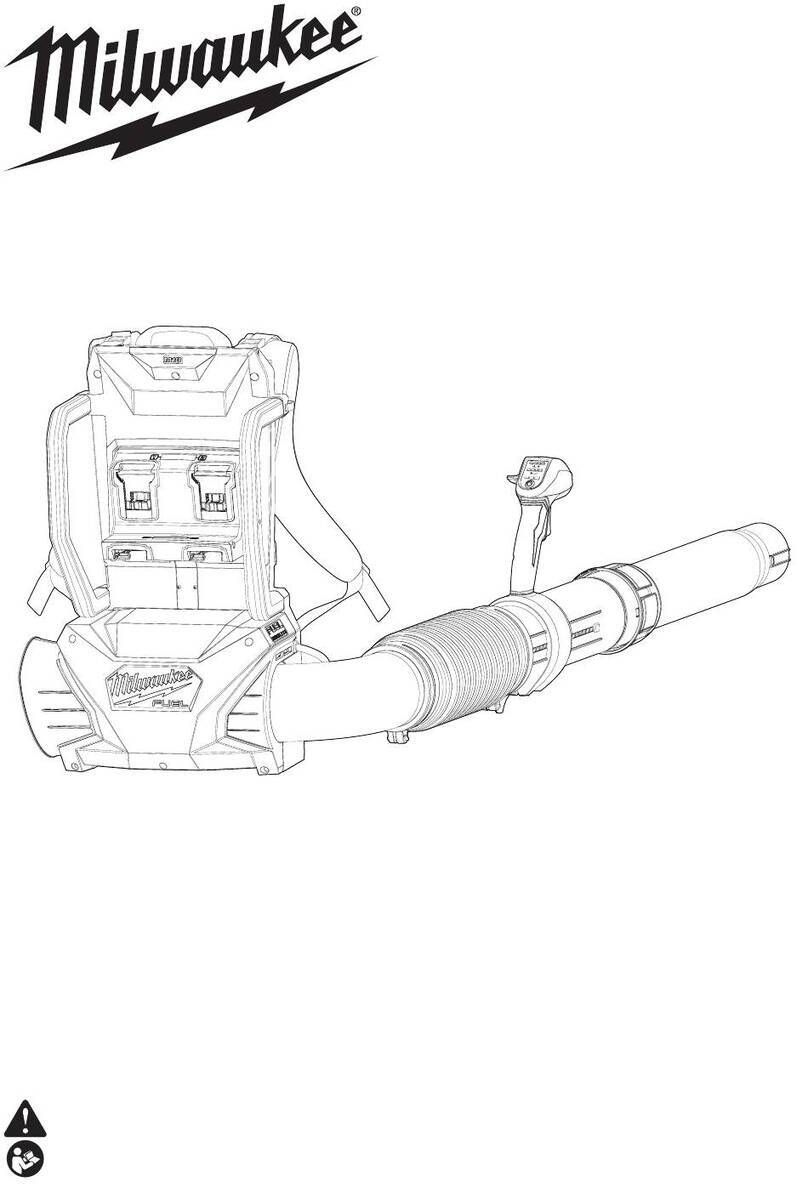
IMPORTANT SAFETY INSTRUCTIONS
•Keep work area clean and well lit. Cluttered or
dark areas invite accidents.
•Blowers have motors and other parts that can
produce sparks during normal use. Donotuse
within 30 feet of areas where explosive materials
may be present (such as gasoline pumps and
placeswhereliquids like paint thinners, cleaners,
solvents, etc. are stored).
•Do not use in the presence of explosive dust,
liquids or vapors.
•Do not use where oxygen or anesthetics are
used.
•Donotallowtobeusedasa toy.Closeattention
is necessary when used by or near children.
•Use extra care when using on stairs.
•Do not handle charger, battery pack or blower
with wet hands.
•Do not blow anything that is burning or smok-
ing such as cigarettes, matches, or hot ashes.
•To reduce the risk of health hazards from va-
pors or dust, do not blow toxic, carcinogenic
or other hazardous materials suchas asbestos,
arsenic, barium, beryllium, lead, pesticides or
other health endangering materials.
•WARNING:Somedustcreatedby powersanding,
sawing, grinding, drilling, and other construction
activities contains chemicals known to cause
cancer, birth defects or other reproductive harm.
Some examples of these chemicals are:
• lead from lead-based paint
• crystallinesilica from bricks and cementandother
masonry products, and
• arsenic and chromium from chemically-treated
lumber.
Yourriskfrom these exposures varies, depending
on how often you do this type of work. To reduce
your exposure to these chemicals: work in a well
ventilated area, and work with approved safety
equipment, such as those dust masks that are
specially designed to filter out microscopic par-
ticles.
•Do not leave blower unattended when battery
pack is installed. Removebattery pack when not
in use and before servicing.
•Do not put any object into openings. Do not
use with any opening blocked; keep free of dust,
lint, hair, and anything else that may reduce air
flow.
•Maintain blower. Check for misalignment or
binding of moving parts, breakage of parts
and any other condition that may affect the
blower's operation. If damaged, have the
blower repaired before use. Many accidents
are caused by poorly maintained tools.
•Maintain labels and nameplates. These carry
important information. If unreadable or missing,
contact a MILWAUKEE service facility for a free
replacement.
•Use blower only with specifically designated
battery packs. Use of any other battery packs
may create a risk of injury and fire.
•Turn off all controls before removing battery
pack.
•To reduce the risk of electric shock, do not
use on wet surfaces. Do not expose to rain.
Store indoors. Do not charge outdoors.
•Recharge only with the charger specified by
the manufacturer. A charger that is suitable for
one type of battery pack may create a risk of fire
when used with another battery pack.
•When battery pack is not in use, keep it away
from other metal objects like paper clips,
coins,keys, nails, screws, or other small metal
objects that can make a connection from one
terminal to another. Shorting the battery termi-
nals together may cause burns or a fire.
•Do not use damaged battery pack or blower.
If battery pack or blower are not working as
they should, have been dropped, damaged, left
outdoors, or dropped into water, return them to a
service center.
•Do not burn or incinerate battery packs. Bat-
tery packs may explode, causing personal injury
ordamage.Toxic fumesandmaterialsare created
when battery packs are burned.
PERSONAL SAFETY
WORK AREA SAFETY
ELECTRICAL SAFETY
WARNING WHEN USING AN ELECTRICAL BLOWER, BASIC
PRECAUTIONS SHOULD ALWAYS BE FOLLOWED, INCLUDING THE FOL-
LOWING:READALLINSTRUCTIONSBEFOREUSINGBLOWER.FORHOUSE-
HOLD OR COMMERCIAL USE. BEFORE USING THE BLOWER, READ THIS
OPERATOR’SMANUAL,YOURBATTERYPACKANDCHARGEROPERATOR’S
MANUALS, AND ALL LABELS ON THE BLOWER, BATTERY PACK, AND
CHARGER.TOREDUCETHE RISK OF FIRE,ELECTRICSHOCK,OR INJURY:
USE AND CARE
BATTERY PACK USE AND CARE
•STAYALERT. Watchwhat you are doing and use
common sense. Do not use blower when you are
tired, distracted or under the influence of drugs,
alcoholormedicationcausing diminished control.
•The operation of a blower can result in foreign
objects being blown into eyes, whichcan result
in eye damage. User and bystanders must wear
safety goggles or glasses with side shields when
blower is in operation.
•Wear a face or dust mask when working in dust
situations. Dust particles can harm your lungs.
•Avoid accidental starting. Ensure the switch
is in the off-position before inserting battery
pack. Inserting battery pack in blower that has
the switch on invites accidents.
•Do not overreach. Keep proper footing and
balance at all times. This enables better control
of the blower in unexpected situations.
•Keep hair, loose clothing, fingers, and all
partsof body away from openings and moving
parts.
•Use only as described in this manual. Useonly
manufacturer’s recommended attachments.
•Do not use to blow flammable or combustible
liquids such as gasoline or use in areas where
they may be present.
READ AND
SAVE ALL
INSTRUCTIONS
FOR FUTURE USE
SERVICE
•Have your power tool serviced by a qualified
repair person using only identical replace-
ment parts. This will ensure that the safety of
the power tool is maintained.
SPECIFIC SAFETY RULES
• Before using the blower, read this operator’s
manual, your battery pack and charger opera-
tor’s manuals, and all labels on the blower,
battery pack, and charger.
• Wear ear protectors. Exposure to noise can
cause hearing loss.
FUNCTIONAL DESCRIPTION
SYMBOLOGY
SPECIFICATIONS
Volts
Direct Current
Underwriters Laboratories, Inc.
United States and Canada
Read operator's manual
Wear eye protection
Cat. No. Volts DC Air Speed Fan Speed
0884-20 18 V 160 MPH 18,000 RPM
1. Trigger
2. Lock-on switch
3. Air flow control
4. Intake
5. Nozzle
6. Extension
7. Inflator/Deflator attachment
6
7
5
4
1
3
2











































